Granada in winter just has a pull I can’t quite shake. When I see the Alhambra’s ancient walls sprinkled with fresh snow, backed by the white Sierra Nevada peaks, it honestly feels like slipping into a dream. Even from a distance, the palace glows against that cold sky in a way you don’t forget.
After soaking up those views, I can’t resist ducking into a snug tapas bar to warm up. The tapas scene buzzes all year, but when the air’s crisp, it feels extra inviting. There’s nothing like grabbing a hot drink and a plate of free tapas in a lively spot after a chilly walk.
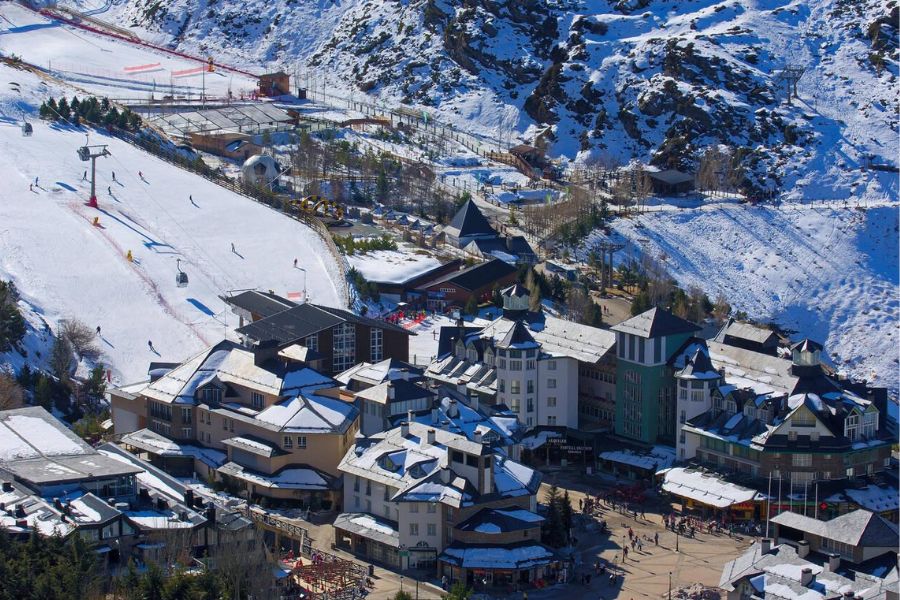
Winter in Granada brings quiet beauty, fewer tourists, and so many little moments to savor—steaming churros, busy street corners, and the smell of wood smoke curling through old stone alleys. Every visit just keeps giving me more reasons to love this city when the temperature drops.
The Alhambra in Winter: A Spectacular Sight from Afar
Snow doesn’t visit Granada often, but when the Sierra Nevada turns white, the Alhambra pops against the wintry backdrop in a magical way. Even from far away, the palace transforms with a layer of frost and cold air. The whole scene feels like a different world.
Why Winter Is the Most Magical Season for the Alhambra
Winter brings a softer, quieter mood to Granada. I rarely see crowds at the city’s viewpoints, so I get to soak up the scenery without much fuss. The Alhambra seems to glow brighter on chilly mornings, especially when frost or snow clings to the roofs.
With the snowy Sierra Nevada behind the palace, every photo just looks incredible. Cold air makes the walls and towers seem sharper. I love how the evening sun sets the reddish stone aglow, making a bold contrast with the white mountains.
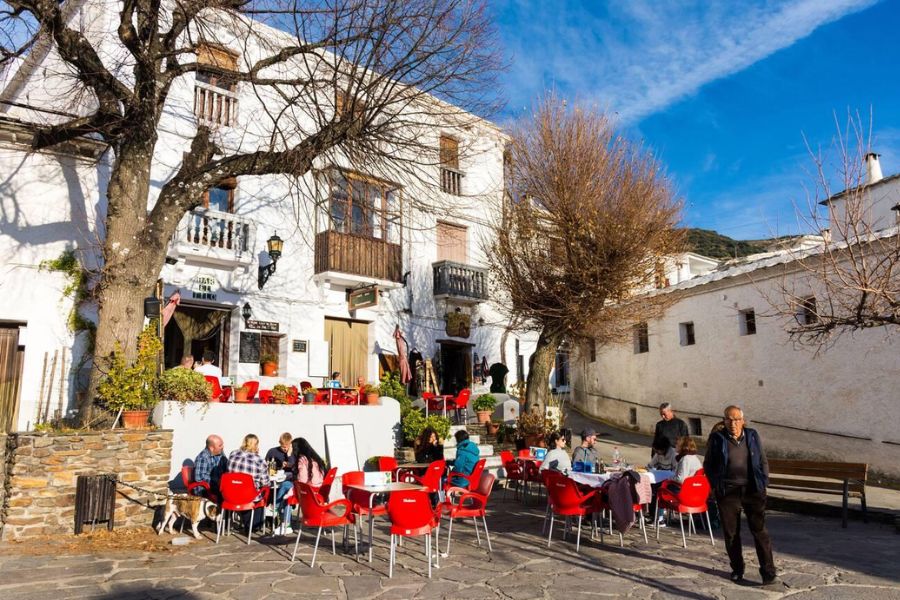
Fewer people visit the Alhambra in winter, so I can find peaceful moments to gaze out at the city and palace. The winter light in Granada, especially at sunrise or sunset, feels softer and more dramatic. It’s my favorite time for slow walks and long, thoughtful pauses.
Where to Catch the Best Snow-Dusted Views
The Mirador de San Nicolás is my top pick for winter views. From up in the Albaicín, I get a full sweep of the Alhambra with snowy peaks behind. If I go early in the morning, I usually have it to myself, coffee in hand, and plenty of time for photos.
I also like the Mirador de San Cristóbal and the gardens in Sacromonte. Walking along the Paseo de los Tristes gives great angles too, especially if the rooftops have a dusting of snow.
Viewpoint tips:
- Mirador de San Nicolás: Wide panorama, best at sunset
- Mirador de San Cristóbal: Higher up, fewer crowds
- Paseo de los Tristes: Closer view, river in the foreground
Sometimes, even from the city center, I catch little glimpses of the palace looking extra magical with a hint of winter.
The Artistry of the Alhambra’s Moorish Architecture in Snow
The Alhambra’s intricate patterns and detailed walls always impress me, but snow somehow makes them pop. Each tower and archway stands out more, as if the cold air sharpens every line. I notice details I’d miss on warmer days.
Delicate carvings look finer when frosted. The garden courtyards, usually busy and green, turn almost silent in winter. Sometimes ice forms on the fountains, sparkling beside the pale stone.
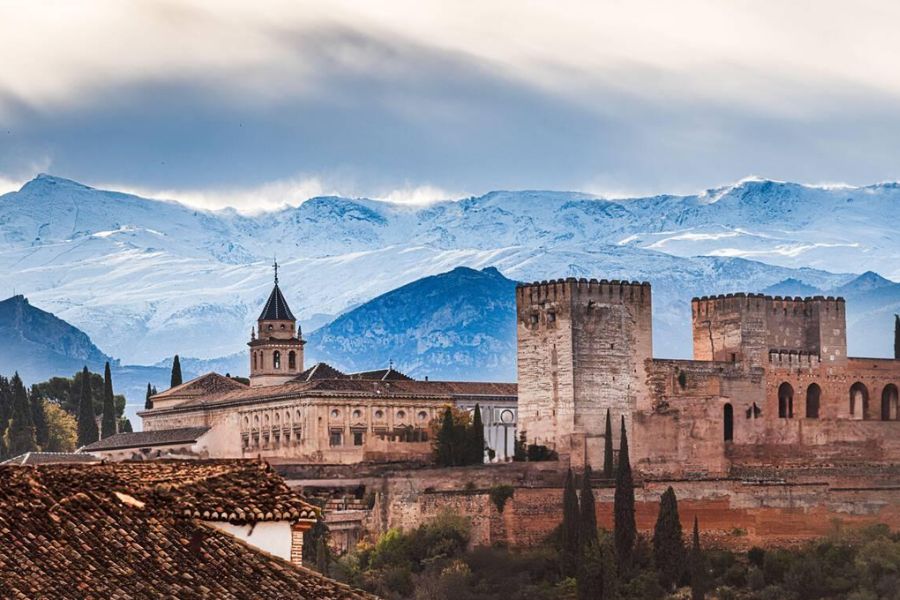
I always love the contrast—those earthy reds against snowy roofs. Moorish arches, latticework, and tiled domes feel even more timeless surrounded by winter’s hush. Seeing the Alhambra in snow gives me a whole new appreciation for its artistry and history.
Chasing Granada’s Rare Snowfall
Catching Granada with a light blanket of snow feels like a rare treat. I’ve figured out when the Sierra Nevada’s peaks shine white and where to find the best snowy Alhambra views.
Typical Weather Patterns and When Snow Appears
Granada’s winters usually stay mild, especially compared to other parts of Europe. Snow in the city itself? Hardly ever. Maybe a dusting on rooftops once or twice a year, if I’m lucky. Most days, the streets stay clear, but the Sierra Nevada mountains start collecting snow from late November through March.
January and February bring the best chances for snowflakes in Granada. Even if the city just gets a few flurries, the mountains behind are often covered by December. The sight of the Alhambra with snowy peaks behind it is what I’m always hoping for. If I wake up to a cold, clear morning, I grab my camera right away.
Scenic Viewpoints for Stunning Photographs
After a fresh snowfall, I head straight to a few classic spots for photos.
Mirador de San Nicolás wins every time—the view of the Alhambra with the Sierra Nevada behind honestly takes my breath away, especially with snow. At sunset, the square fills up with people all chasing that postcard shot.
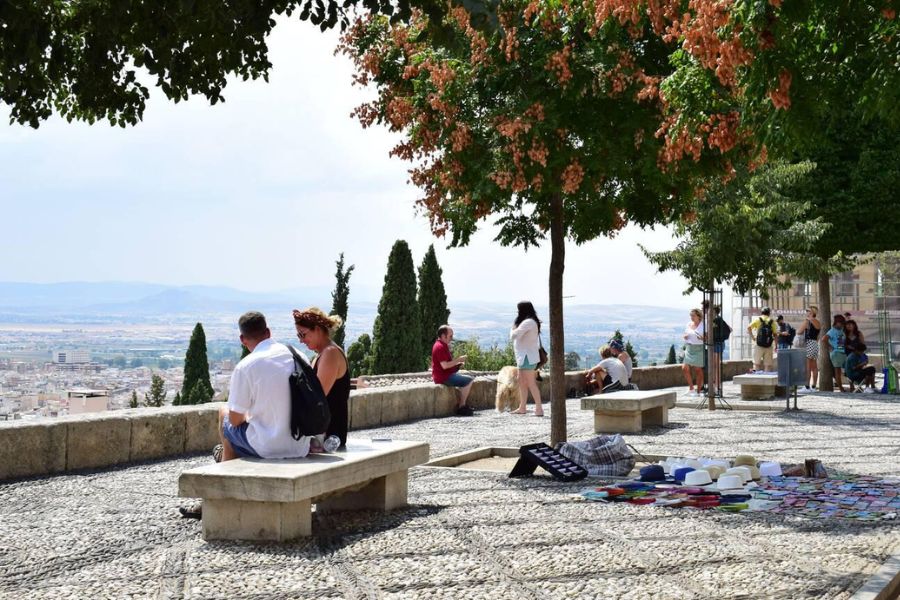
Mirador de San Miguel Alto sits higher and offers wide, quiet views. From up there, I can see the whole city and the mountain range. I also like Paseo de los Tristes, which follows the Darro River and frames the Alhambra against the icy backdrop.
| Viewpoint | Why I Love It |
|---|---|
| Mirador de San Nicolás | Iconic sunset views |
| San Miguel Alto | Wide, quiet panoramas |
| Paseo de los Tristes | River + Alhambra contrast |
If you want the best light, show up early or right before sunset. Winter days are short, and the golden hour really makes those snowy scenes glow.
Warming Up with Tapas After Your Winter Walk
Granada gets brisk in winter, but the city’s tapas bars are a lifesaver. After walking by the Alhambra with the snowy Sierra Nevada in view, I can’t wait to slip into a cozy bar, grab a seat by the fire, and split a few plates with friends.
Traditional Granada Tapas for Chilly Days
When it’s cold, I see locals leaning toward heartier dishes. Some classics always call my name. I usually start with a steaming bowl of patatas bravas—fried potatoes with spicy sauce. Berenjenas con miel (fried eggplant with local honey) is another favorite, crisp and sweet at the same time.
If I want something filling, I go for albondigas (meatballs in sauce) or a plate of callos (stewed tripe), which is a true winter classic. Dipping thick bread into pisto (Spanish ratatouille) is a must for a burst of flavor. Many bars bring a hot tapa with your drink, so I keep an eye out for seasonal specials on cold nights.
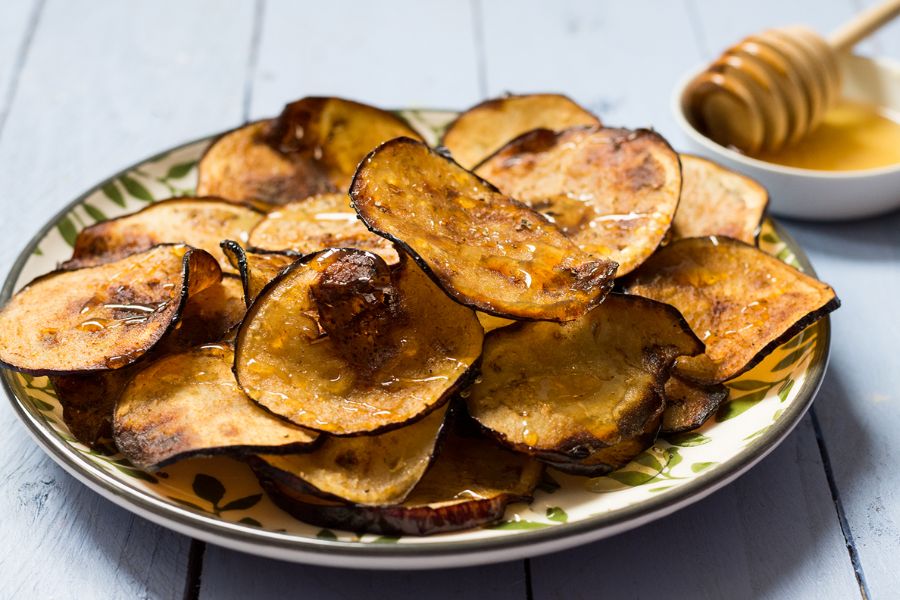
Popular Tapas for Cold Weather:
| Tapa Name | Description |
|---|---|
| Patatas Bravas | Spicy fried potatoes |
| Berenjenas con Miel | Fried eggplant with honey |
| Albondigas | Juicy meatballs in tomato sauce |
| Callos | Slow-cooked tripe stew |
| Pisto | Warm vegetable and tomato stew |
Top Local Tapas Bars Near the Alhambra
After a winter walk near the Alhambra, I don’t have to go far to find a great bar. Calle Navas—just a quick stroll from the palace—lines up tapas spots that feel especially welcoming in the cold. Bar Los Diamantes and Bodegas Castañeda stand out for their old-school charm and lively vibe. I love how staff bring a free tapa with every drink, so you can taste a bunch without spending much.
When I want things quieter, I duck into a small bar tucked on a side street near Plaza Nueva. A warm fireplace or old wooden beams overhead just make it all feel cozier. No winter visit feels complete without squeezing into a local favorite, watching steam rise from a hot tapa, and catching bits of conversation around me.
My Favorite Bars Near the Alhambra:
- Bar Los Diamantes
- Bodegas Castañeda
- La Tana (for excellent local wine)
- Casa Enrique (for traditional stews)
Pairing Tapas with Local Wines and Spirits
Granada’s wines and spirits turn winter tapas into something special. I usually start with a glass of vino tinto from nearby Andalucía vineyards. Those reds warm me up fast and pair well with anything spicy or rich. If I’m eating cheese or lighter tapas, I go for a crisp white Verdejo.
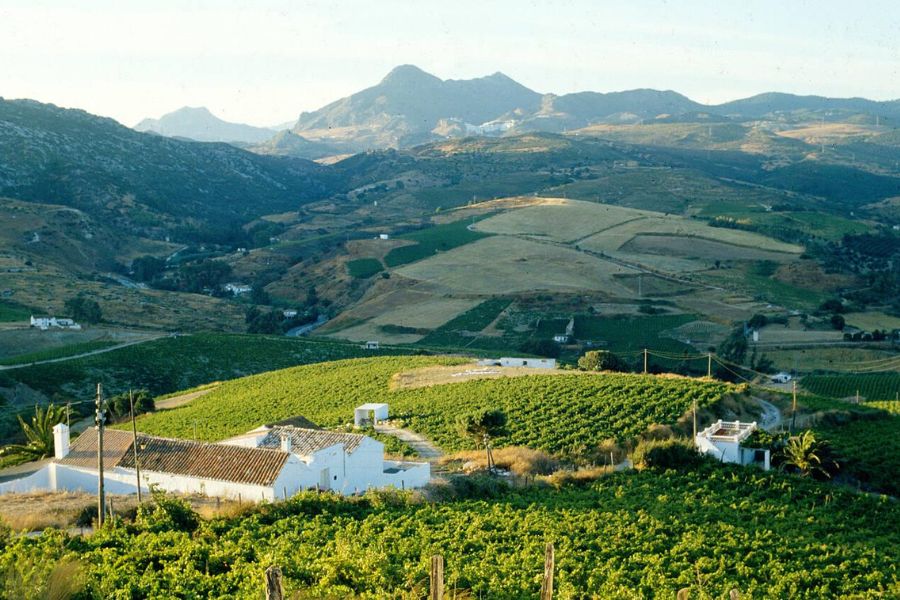
Fried tapas like eggplant or calamari match perfectly with vermut, a local vermouth served over ice with orange and an olive. Sometimes I’ll order a shot of anís seco, an herbal spirit that’s popular after a big meal. Many bars also have their own sherries—served chilled or room temp—which really bring out the flavor in winter dishes.
Suggested Drink & Tapa Pairings:
| Drink | Best Tapas Pairing |
|---|---|
| Vino Tinto | Albondigas, Callos |
| Verdejo | Pisto, light seafood tapas |
| Vermut | Berenjenas con Miel, Calamari |
| Anís Seco | Pastries or cheeses |
| Sherry | Saucy or spicy meat dishes |
No winter bar-hop in Granada feels right without at least one dip into the local drinks menu. It’s part of the fun as city lights twinkle outside and the warmth fills your glass.
Practical Tips for Enjoying Granada in Winter
If you visit Granada in winter, pack for cold, find cozy places to stay, and take advantage of quieter streets and attractions. Snow on the Alhambra is a treat, but you’ll want to be ready for whatever winter brings.
What to Pack for a Chilly Granada Getaway
Granada in winter can get cold, with daytime highs around 10°C (50°F) and colder nights. Layers are my best friend. I always pack a warm coat, sweater, hat, and gloves. Thermal base layers help a lot. Waterproof boots are a must, especially after rain or the odd snow.

Packing List:
| Item | Why You Need It |
|---|---|
| Warm coat/jacket | Nights get chilly |
| Sweater or fleece | Easy to layer |
| Scarf, hat, gloves | Extra warmth |
| Waterproof boots | Keeps feet dry and warm |
| Umbrella | For winter rain |
| Thermal underwear | Adds warmth without bulk |
I use vacuum pack bags to save space in my suitcase. That way, bulky stuff doesn’t take over, and I have room for souvenirs.
Navigating Winter Transport and Accommodation
Granada’s city center is easy to walk, but winter means shorter days. I check bus and Alhambra ticket times ahead, since some attractions close earlier than in summer. If it snows, city roads usually stay clear, but I’ve noticed taxis can be busy on wet days.
For places to stay, I pick somewhere with good heating. Old buildings can be drafty, so I double-check reviews for warmth. Smaller guesthouses often feel cozier and more personal.
Booking ahead usually gets me better rates, especially around holidays. If I’m driving, I keep an eye on weather apps since the Sierra Nevada can get heavy snow, and mountain roads might be tricky.
Making the Most of Fewer Crowds
Winter rolls in and suddenly Granada feels so much more relaxed. Tourists thin out, and I didn’t have to scramble for Alhambra tickets—there were even some available that same week.
Wandering through Albaicín’s hilltop streets felt peaceful. No crowds pressed in, just quiet corners and winding lanes.
Tapas bars along Calle Navas and nearby streets had open tables. The staff actually had time to chat and shared their favorite winter dishes and wines.
Museums and flamenco shows felt almost intimate. I grabbed great seats without any rush.
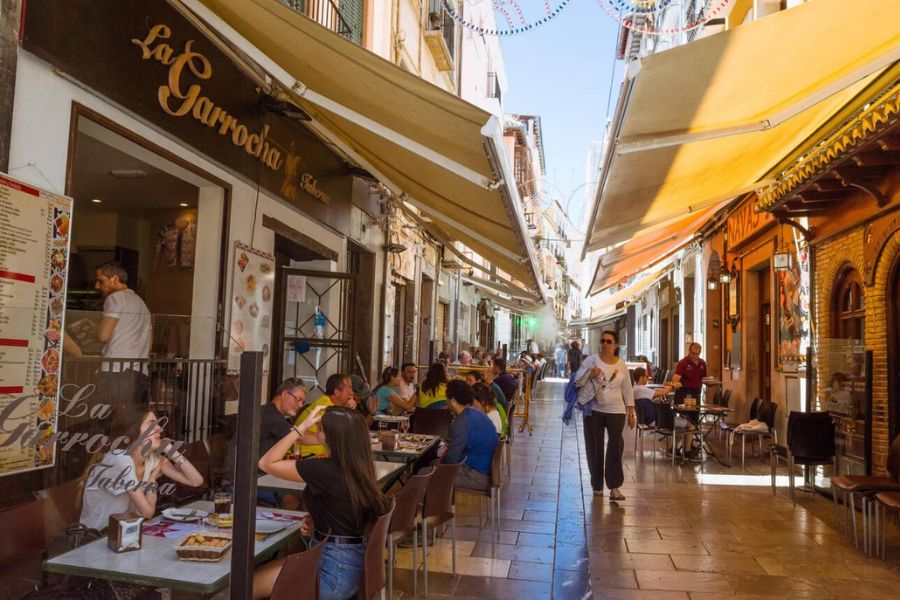
It’s easy to slip into the local rhythm here. Slow walks, lingering tapas lunches, and those quiet evenings when the city feels like it’s yours.
Flavors of Granada: Beyond Tapas
Granada warms me up in winter, not just with cozy tapas bars, but with rich comfort foods and the craft of hand-carved jamón.
Eating here is all about texture, scent, and tradition. Honestly, every table seems to have its own story.
Winter Comfort Foods Worth Savoring
When the air turns crisp, I spot hearty stews and warm plates everywhere. One of my favorites? Plato alpujarreño—it’s a pile of fried potatoes, eggs, chorizo, and jamón. Locals swear it’s just right after a chilly walk.
A classic Granada winter meal list looks something like this:
- Olla de San Antón – a rich, thick rice and pork stew
- Sopa de ajo – garlicky bread soup that hits the spot, especially at night
- Piononos – tiny, syrup-soaked pastries from Santa Fe
I love grabbing a seat by the window when it’s snowing, letting the steam from sopa de ajo fog up my glasses. There’s a certain cozy vibe that sticks with you long after the meal ends.
These dishes, usually found in small, family-run spots, give you more than just a full stomach—they’re a real taste of Granada’s winter soul.
Savoring Spain’s Iconic Jamón: How Locals Debone and Serve It
Jamón serrano and jamón ibérico pop up just about everywhere in Granada. Still, nothing really beats watching a local pull out all the stops—deboning and slicing it right in front of me.
This whole thing feels like an art form. Families often pass down the technique for generations.
I usually spot them setting the whole cured leg in a sturdy wooden holder. Then, with a long, thin knife, they start peeling away the outer skin and fat.

Their hands move fast but somehow look relaxed. They work the knife around the bones, freeing the meat and quickly slicing off those paper-thin pieces that just melt away on my tongue.
Here’s what they do, step by step:
- Secure and clean the ham
- Debone along the natural bone lines
- Slice thin, even pieces
Nobody rushes good jamón. Watching the carver, I almost zone out—it’s oddly calming.
Every bite bursts with this deep, nutty flavor. Locals usually serve it with some fresh bread, or sometimes they just let the jamón stand alone. I totally get why; the taste really doesn’t need anything else.
Honestly, seeing this tradition up close sticks with me—almost as much as any view of the Alhambra.

